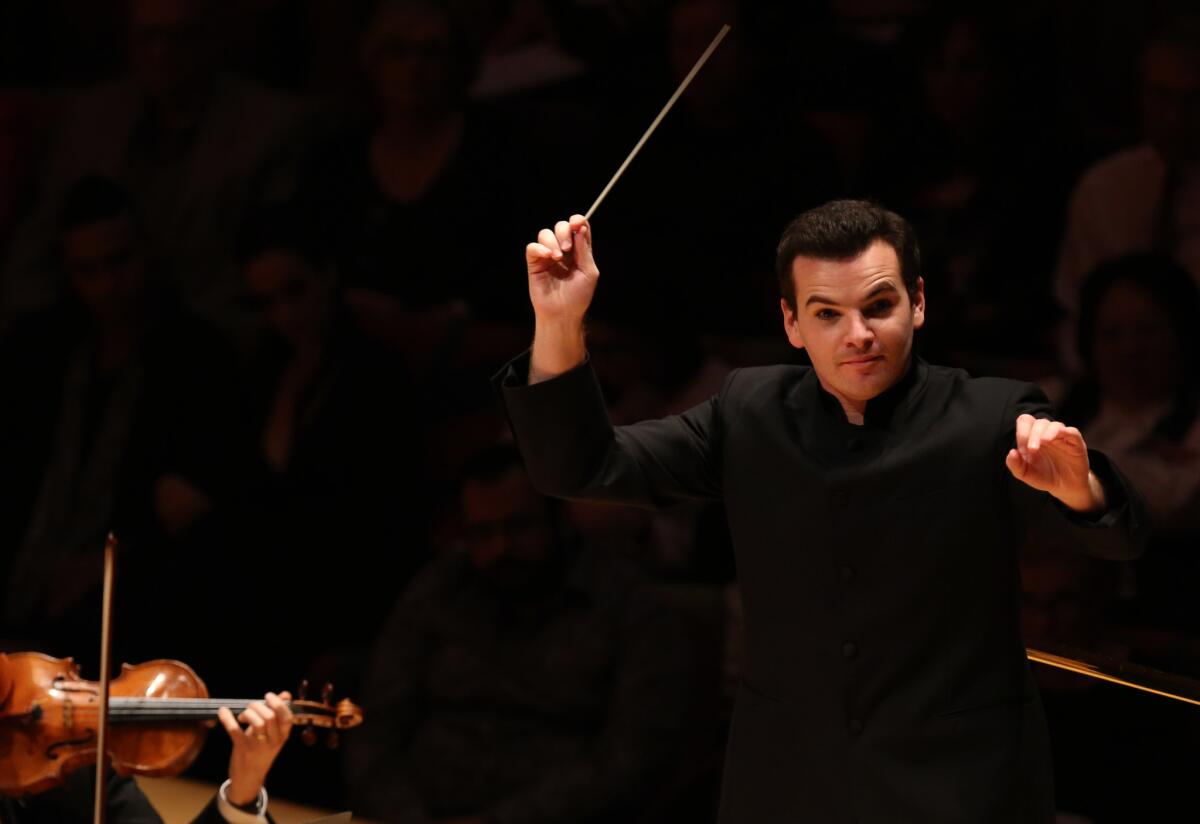Year in Review: Mark Swed’s best classical moments of 2014

- Share via
Half of this year’s top 10 happened to involve early music. Don’t ask why; it’s probably just a coincidence. But we need perspective in our hyperactive culture, which maybe, down deep, is not changing as fast as Silicon Valley would like us to believe. The relevance of Bach and Handel in particular but other Baroque masters as well can be — and this year was — uncanny. That’s reason to rejoice.
Two great Peters’ passion for “St. Matthew”: It was an extraordinary year for Bach’s “St. Matthew Passion.” Peter Brook’s eloquent cry for compassion in a territory of terror — his production of the apartheid South African drama “The Suit” at UCLA — began with Bach’s final “St. Matthew” bass aria of benevolence and renewal. Meanwhile, Peter Sellars brought his revelatory, communal Berlin Philharmonic staging of Bach’s masterpiece to the London Proms and New York.
Fifths of Dudamel: Gustavo Dudamel’s probing performances of Beethoven’s Fifth Symphony at the Hollywood Bowl, followed by his Mahler’s Fifth in Walt Disney Concert Hall to begin his fifth season as L.A. Phil music director, revealed a young conductor’s exceptional maturation in the seven short years since he had first performed these symphonies at Disney with his Simón Bolívar Youth Orchestra. Dudamel’s exuberance is still notable, but it now carries a new weight of emotional depth and complexity.
Baroque bad boys: Two of the most radical Baroque composers had anniversaries little noticed in our neighborhood. The record companies, however, were on the case. The most startling among many fine new Rameau releases was conductor Teodor Currentzis’ “The Sound of Light,” showing Rameau as a composer of indescribable pleasures. Clavichordist Jocelyne Cuiller devised a C.P.E. Bach disc with various French friends that features such surprises as queasy settings of Hamlet’s “To be or not to be” and of Socrates’ hemlock-intoxicated final soliloquy. Some the strangest Shakespeare and Plato settings ever are joined by equally astonishing keyboard and flute sonatas.
Mining music with a little help from video and film: Julia Wolfe’s “Anthracite Fields,” part of the New York Philharmonic’s first biennial of new music, proved an unforgettably haunting, harrowing evocation of the plight of Pennsylvania’s coal miners, incorporating many musical styles and effectively shadowy visuals. At UCLA, filmmaker Bill Morrison’s “The Miner’s Hymns,” containing poignant found footage from northeast England, was accompanied by somber, aptly sour and also haunting brass (and strings and electronics) by the moody Icelandic composer Jóhann Jóhannsson.
The unclassical style: Steven Stucky’s “The Classical Style” — an absurd, short comic opera with a sidesplitting libretto by pianist Jeremy Denk based on a musicological study of the music of Haydn, Mozart and Beethoven — became the first opera to have its premiere at the Ojai Festival. It is also the first opera to have musical chords treated as needy characters at a bar. The opera’s real accomplishment, though, is as a meaningful and original study in how to transform the silly into the sublime.
L.A. Phil assistants on the rise: Former L.A. Phil assistant and associate conductor Lionel Bringuier moved to Zurich, where he opened his first season as music director of the venerable Tonhalle orchestra in September with a concert that had Esa-Pekka Salonen, Gustavo Dudamel and Frank Gehry in the audience leading a standing ovation. Back at the L.A. Phil, Lithuanian conductor Mirga Grazinyte-Tyla, a former Dudamel fellow and newly appointed the orchestra’s latest assistant conductor, made her Hollywood Bowl debut with a knockout performance of Mahler’s First Symphony.
A Dido/BB-gun for L.A. Opera: There is little if any connection between Henry Purcell’s deliciously understated 17th century “Dido and Aeneas” and Bartók’s early 20th century psychosexual study in the fine art of wife killing, “Bluebeard’s Castle.” But Australian director Barrie Kosky’s kinky yet powerful production made this a visually and musically convincing double bill, proving that Los Angeles Opera has its mojo back big time.
The Bay Area’s handle on Handel: In the spring at Berkeley, Mark Morris turned Handel’s “Acis and Galatea” into a danced opera full of joy. In the fall, director Christopher Alden found weird — and yet more kinky — delight, with the estimable help of countertenor David Daniels, in San Francisco Opera’s rare and wonderful outing of Handel’s “Partenope.”
Costa Mesa’s handle on Handel: No kink here; the composer’s late oratorio “Theodora” is a four-hour contemplation of spiritual constancy amid global chaos. A considered, probing performance by the English Consort conducted by Harry Bicket (also starring David Daniels) at Segerstrom Hall stayed a course few world leaders these days manage.
Kronos and Arditti reach middle age in their prime. The two leading string quartets devoted to our time turned 40. Kronos celebrated at UCLA with Laurie Anderson’s magically melancholic response to Hurricane Sandy. Two days later, thanks to the Monday Evening Concerts, the Arditti featured exceptional performances of British, American and German modernist masters.
The worst: the Music Center’s midlife crisis: Despite a half-century of accomplishments, the Music Center resembled an inappropriate 50-year-old trying to act young. The 50th-anniversary celebration at the Dorothy Chandler Pavilion became an outsourced, over-amplified, Vegas-style variety show, as though one of the world’s greatest performing arts centers were envious of the tacky Dolby Theatre in Hollywood.
Twitter: @markswed
More to Read
The biggest entertainment stories
Get our big stories about Hollywood, film, television, music, arts, culture and more right in your inbox as soon as they publish.
You may occasionally receive promotional content from the Los Angeles Times.











